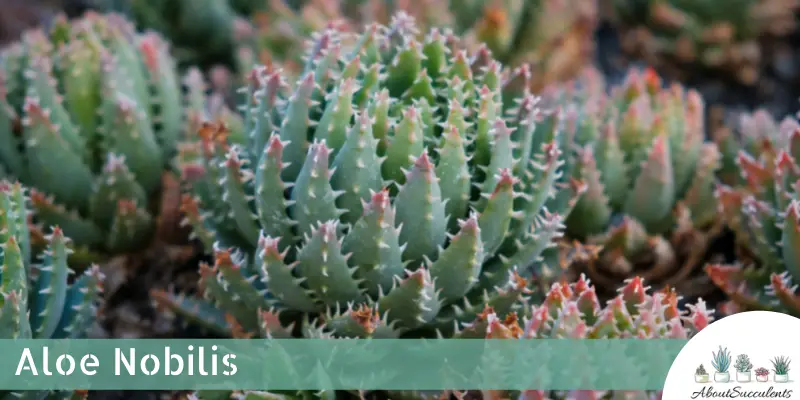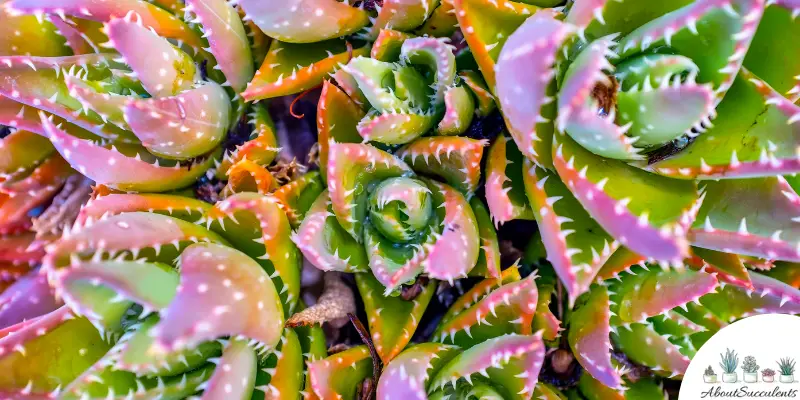
Aloe Nobilis is also called Gold-Tooth Aloe because its large green leaves have white, gold spines that look like teeth on its edges.
The teeth look sharp but they’re harmless. The green leaves turn orange when they are exposed to bright sunlight. In some types of this succulent, the leaves might reveal other colors such as rose, yellow, and white.
Gold-Teeth aloe is an evergreen perennial that develops small, triangular rosettes, and produces red flowers in the summertime.
Aloe Nobilis is native to South Africa and is a member of the Asphodelaceae family. It can grow up to 61cm (12”) in height and width.
General Information:
Also known as: Gold Tooth Plant
Plant Family: Asphodelaceae
Origin: South Africa
Height: 30cm (12-inches)
Exposure: Partial sun
Water Needs: Drought-tolerant; water only when the soil is dry to the touch.
Soil Type: Standard potting soil mix with sand and gravel.
Soil pH: 7.0 to 8.5
How To Grow and Care for Aloe Nobilis

Aloe Nobilis is a popular succulent for landscapers, xeriscapers, and indoor gardeners. It can be planted in a rock garden or a terrarium.
Gold Tooth Aloe is compact and spreads quickly that you might want to include it as part of a small garden of potted succulent plants or as ground cover.
This is not a cold-hardy succulent plant and thrives in regions with temperatures of -6.7 °C (20 F).
Sunlight
Aloe nobilis can be grown as an indoor plant but it’s better suited to the outdoors. In the garden, plant the succulent in an area that gets 6 hours of sunlight but free from the scorching heat of the afternoon sun. Exposure to high heat temperatures can burn its leaves.
If the temperature in your region drops below -4° C (25° F), it’s recommended to plant Gold Tooth Aloe in a pot that can be moved indoors. Place the pot in a location that can get partial to full sunlight for 3 to 6 hours.
Aloe nobilis produces flowers when consistently exposed to sunlight. Direct sunlight exposure is important during the colder months of the year and to partial sunlight when the months become hotter in the summertime.
Watering
Aloe Nobilis is one of the easiest succulents to grow and take care of because as a drought-tolerant plant, it doesn’t require a lot of water.
Use the soak and dry method whereby the soil feels dry to the touch before watering. You can insert a stick one-inch into the soil to be sure. If the end of the stick feels dry then you can water.
The general rule is to water moderately in the summer months and very sparingly during the colder months when the soil tends to remain moist for a longer time.
Water the soil and not the plant.
Pot and Soil
Similar to other drought-tolerant succulents, Aloe Nobilis grows better when planted in a pot that has good drainage and allows the proper evaporation of moisture from the soil.
The best pot for this perennial succulent is either ceramic or terra cotta. Make sure the pot has a drain hole with mesh material at the bottom.
Aloe Nobilis will grow well in standard potting soil that’s mixed with gravel and sand in order to improve drainage.
Liquid fertilizer can help improve the quality of the soil. Spring and summer time are the best seasons to add liquid fertilizer.
How to Propagate Aloe Nobilis
Kalanchoe Pumila is popular with horticulturists because you can propagate it from stems or leaf cuttings. Your chances of successful propagation will be greater if you use cuttings from st
Another reason why horticulturists love this succulent plant is because Gold Tooth Aloe produces many offsets that appear at its base.
This type of succulent is easy to propagate and multiplies very quickly. There are 3 methods of propagation: Seed, leaf cuttings and offsets.
Method 1 – Seed Method
Step 1: The seeds are found inside the pods. Wait for the pods to ripen before removing them from the plant.
Step 2: Place a container under the pods to capture seeds that will fall out. Split the pods in order to harvest the seeds.
Step 3: Sow the seeds in a small container filled with standard potting soil mix and improved with ⅔ coarse sand, ⅓ universal substrate at a temperature of 18-24 ° C (6 4.4 to 75.2° F).
Method 2 – Leaf Cuttings Method
Step 1: Use a sterilized and sharpened set of garden shears or a knife to remove a healthy leaf from the stem. Cut cleanly and make sure there are no parts of the leaf on the stem to ensure a successful propagation.
Step 2: Place the leaf in a clean, dry area for 2 to 3 days or until it develops hard calluses.
Step 3: Place the callused leaf on top of standard potting mix and cover it with plastic wrap.
Step 4: When you see growth after a few weeks, remove the plastic and water the soil lightly.
Method 3 – Offsets Method
Step 1: Gently pull out the offsets at the base of the mother plant.
Step 2: Leave the offsets in a dry place and allow them to develop hard calluses after a few days.
Step 3: Plant the offsets in a standard potting soil mix. Lightly water the soil when it feels dry to the touch.
Frequently Asked Questions
Is Aloe Nobilis Toxic to Cats and Dogs?
Aloe Nobilis or Gold Tooth Aloe is not found on the list of toxic plants for cats and dogs in the website of the American Society for the Prevention of Cruelty to Animals (ASPCA).
Why Is My Aloe Nobilis Dying?
There are 2 main factors that may cause your Aloe Nobilis succulent to die: Overwatering and pest infestation.
Overwatering
The growth of fungi is the number one cause of death for succulents. Overwatering results in the root rot and this develops into fungi.
If you see fungi appear on the plant’s leaves or stems, cut these parts right away by using a sharpened but sterilized pair of garden shears.
Gently remove the succulent plant from the soil and check for root rot. Cut off roots that show signs of rotting. Place the Gold Tooth Aloe in a dry area while you refill a new pot with fresh potting mix.
Transfer Aloe Nobilis to the new pot.
Pest Infestation
Aloe Nobilis is a favorite source of food by pests such as mealybugs, aphids, snails, slugs, and a few variety of birds.
These pests carry diseases that can become deadly for the succulent. Remove mealybugs and aphids by spraying the succulent plant with neem oil. You can remove mealybugs by wiping the leaves with 70% isopropyl alcohol.
Does Aloe Nobilis Produce Flowers?
Yes, Aloe Nobilis produces red, tubular-shaped flowers in the summertime.
Last Updated on June 9, 2022 by Sofia Lara